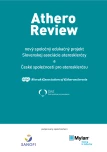What is the most important for patients with familial hypercholesterolaemia?
MedPed project in the Czech and Slovak
Authors:
Michal Vrablík 1; Katarína Rašlová 3; Tomáš Freiberger 2; Richard Češka Katarína Rašlová 1 3; Branislav Vohnout 3
Authors‘ workplace:
Centrum preventivní kardiologie III. interní kliniky 1. LF UK a Všeobecná fakultní nemocnice, Praha, Česká republika
1; Genetická laboratoř, Centrum kardiovaskulární a transplantační chirurgie, Brno, Česká republika
2; Koordinačné centrum pre familiárne hyperlipoproteinémie, Slovenská zdravotnícka univerzita v Bratislave, Slovenská republika
3
Published in:
AtheroRev 2016; 1(1): 28-33
Category:
Reviews
Overview
In the ninetieth of the last century a new initiative aiming at early identification of patients with familial hypercholesterolaemia (FH) endangered by myocardial infarction and premature death emerged in Utah, USA. Its goal comprised diagnosis of the disease in asymptomatic stadium focusing on relatives of patients with a history of an ischaemic event and prevention of premature death and vascular events by early initiation of lipid lowering medications. This project entitled MedPed (Make Early Diagnosis to Prevent Early Deaths) disseminated to more than 30 countries worldwide and gained WHO support. The Czech and Slovak Republic joined the project in 1998. Thanks to the support from the Czech Society for Atherosclerosis and Slovak Association of Atherosclerosis a large network of cooperating centres dealing with the diagnosis and management of FH and other severe dyslipidaemias has been created. Due to efforts of medical teams the number of identified FH probands has been steadily growing and to date there are more than 6 000 and 1 900 FH patients identified in the Czech and Slovak Republic which ranks among the most successful in this respect worldwide. This was enhanced also by the development and accessibility of molecular diagnostics of FH. Thus, the answer to the question raised in the headline of the article seems obvious: the most important is early diagnosis and early management of FH, which is made possible within the MedPed project.
Key words:
cascade screening – familial hypercholesterolaemia – MedPed project – molecular genetics
Sources
1. Benn M, Watts GF, Tybjaerg-Hansen A et al. Familial hypercholesterolemia in the Danish generalpopulation: prevalence, coronary artery disease, and cholesterol-lowering medication. J Clin Endocrinol Metab 2012, 97(11): 3956–3964.
2. Nordestgaard BG, Chapman MJ, Humphries SE et al. Familial hypercholesterolaemia is underdiagnosed and undertreated in the general population: guidance for clinicians to prevent coronary heart disease. Eur Heart J 2013, 34(45):3478–3490a.
3. Goldstein JL, Hobbs HH, Brown MS. Familial hypercholesterolemia. In: Scriver CR, Beaudet AL, Sly Ws et al. The metabolic and molecular bases of inherited disease. 4 voll. 8th ed. McGraw-Hill: New York 2001 : 2863–2914. ISBN 978–0071163361.
4. Williams RR, Schumacher MC, Barlow GK et al. Documented need for more effective diagnosis and treatment of familial hypercholesterolemia according to data from 502 heterozygotes in Utah. Am J Cardiol 1993; 72(10): 18D-24D.
5. Williams RR, Hunt SC, Schumacher MC et al. Diagnosing heterozygous familial hypercholesterolemia using new practical criteria validated by molecular genetics. Am J Cardiol 1993; 72(2): 171–176.
6. Familial hypercholesterolemia. Report of a second WHO Consultation. World Health Organization: Geneva 1999 (WHO publication No. WHO/HGN/FH/CONS/99.2). Dostupné z WWW: http://apps.who.int/iris/bitstream/10665/66346/1/WHO_HGN_FH_CONS_99.2.pdf.
7. Tichý L, Freiberger T, Zapletalová P et al. The molecular basis of familial hypercholesterolemia in the Czech Republic: spectrum of LDLR mutations and genotype-phenotype correlations. Atherosclerosis 2012; 223(2): 401–408.
8. Soška V, Freiberger T, Cífková R et al. Plasma HDL-cholesterol and triglyceride levels in familial hypercholesterolemia: data from the MedPed CZ database and the Czech population. Clin Chim Acta 2011; 412(11–12): 920–924.
9. Soška V, Jarkovský J, Ravčuková B et al. The logarithm of the triglyceride/HDL-cholesterol ratio is related to the history of cardiovascular disease in patients with familial hypercholesterolemia. Clin Biochem 2012; 45(1–2): 96–100.
Labels
Angiology Diabetology Internal medicine Cardiology General practitioner for adultsArticle was published in
Athero Review

2016 Issue 1
- Hope Awakens with Early Diagnosis of Parkinson's Disease Based on Skin Odor
- Memantine Eases Daily Life for Patients and Caregivers
- Metamizole vs. Tramadol in Postoperative Analgesia
- Memantine in Dementia Therapy – Current Findings and Possible Future Applications
- What Effect Can Be Expected from Limosilactobacillus reuteri in Mucositis and Peri-Implantitis?
Most read in this issue
- Familial hypercholesterolemia: clinical reports, molecular genetics and differential diagnosis
- PCSK9 inhibitors in the management of patients with high cardiovascular risk – effective treatment to reach
- Turn in hypercholesterolemia treatment – PCSK9 inhibitors. What we know about the alirocumab (product Praluent®) yet?
- Statin-associated myopathy: clinical guideline of Slovak Atherosclerosis Association and Czech Society for Atherosclerosis
